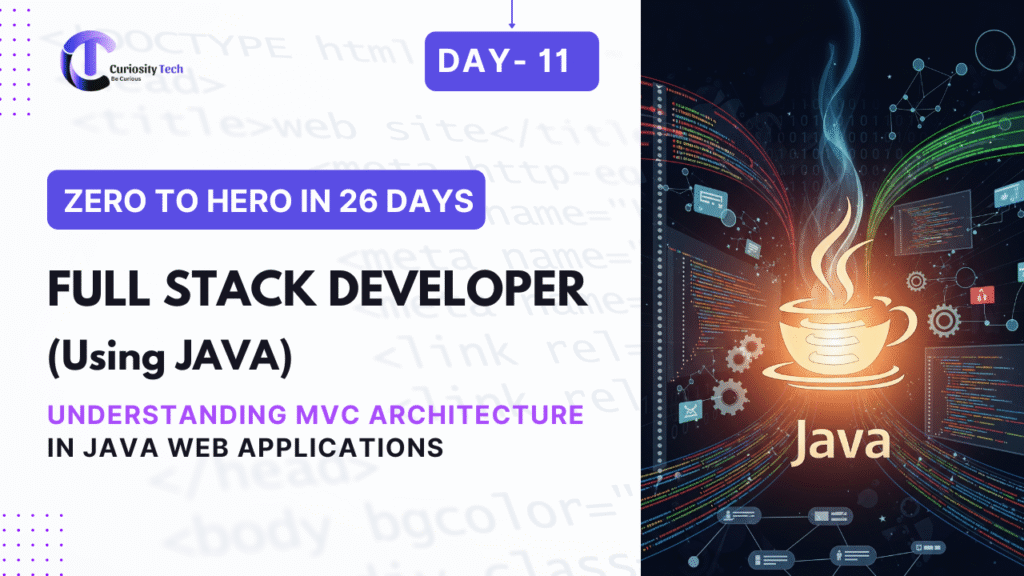Introduction
For a Java Full Stack Developer, understanding the MVC (Model-View-Controller) architecture is essential. MVC is a design pattern that separates application logic into three interconnected components: Model, View, and Controller. This separation makes applications easier to manage, scale, and test.
At CuriosityTech, we emphasize real-world application of MVC with Spring Boot, enabling developers to build structured, maintainable, and professional Java web applications.
Why MVC is Important
- Separation of Concerns – Keeps business logic separate from presentation.
- Maintainability – Easier to update and manage large applications.
- Testability – Each component can be tested independently.
- Reusability – Models and views can be reused in multiple parts of the application.
CuriosityTech ensures learners understand MVC deeply, preparing them for full stack projects that are clean, scalable, and efficient.
Components of MVC
| Component | Responsibility |
| Model | Represents application data and business logic |
| View | Handles presentation, typically HTML/CSS/JavaScript or Thymeleaf templates |
| Controller | Processes user requests, interacts with the model, and returns the appropriate view |

Description:
- The user interacts with the view (frontend).
- The controller receives input, processes it via the model.
- The model interacts with the database.
- The controller updates the view, which presents results back to the user.
Practical Example with Spring Boot
1. Model Class (Product)
@Entity
public class Product {
@Id
@GeneratedValue(strategy = GenerationType.IDENTITY)
private Long id;
private String name;
private Double price;
// Getters and setters
}
2. Repository
public interface ProductRepository extends JpaRepository<Product, Long> {}
3. Controller
@Controller
public class ProductController {
@Autowired
private ProductRepository repo;
@GetMapping(“/products”)
public String listProducts(Model model){
model.addAttribute(“products”, repo.findAll());
return “products”;
}
@PostMapping(“/products”)
public String addProduct(@ModelAttribute Product product){
repo.save(product);
return “redirect:/products”;
}
}
4. View (Thymeleaf Template)
<!DOCTYPE html>
<html xmlns:th=”http://www.thymeleaf.org”>
<head>
<title>Products</title>
</head>
<body>
<h1>Product List</h1>
<form th:action=”@{/products}” method=”post”>
<input type=”text” th:field=”*{name}” placeholder=”Product Name” required />
<input type=”number” th:field=”*{price}” placeholder=”Price” required />
<button type=”submit”>Add Product</button>
</form>
<table border=”1″>
<tr><th>Name</th><th>Price</th></tr>
<tr th:each=”product : ${products}”>
<td th:text=”${product.name}”></td>
<td th:text=”${product.price}”></td>
</tr>
</table>
</body>
</html>
Best Practices in MVC Development
- Keep business logic inside Model or Service layers, not in the controller.
- Use Thymeleaf or JSP for clean and maintainable views.
- Handle exceptions gracefully in the controller using @ExceptionHandler.
- Organize packages by layers (model, repository, controller, service).
- Make views reusable and dynamic to reduce redundancy.

Integrating CuriosityTech Perspective
At CuriosityTech, students learn MVC not just as a theory, but through project-based examples such as inventory management apps and e-commerce websites. This ensures learners can build real-world full stack applications with structured, maintainable code.
Conclusion
Mastering MVC architecture is a turning point in becoming a competent Java Full Stack Developer. By separating application logic into Model, View, and Controller, developers achieve maintainable, scalable, and testable applications. CuriosityTech.in equips developers with the hands-on experience needed to implement MVC effectively in professional projects, bridging the gap between theoretical knowledge and real-world.



